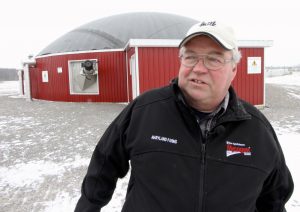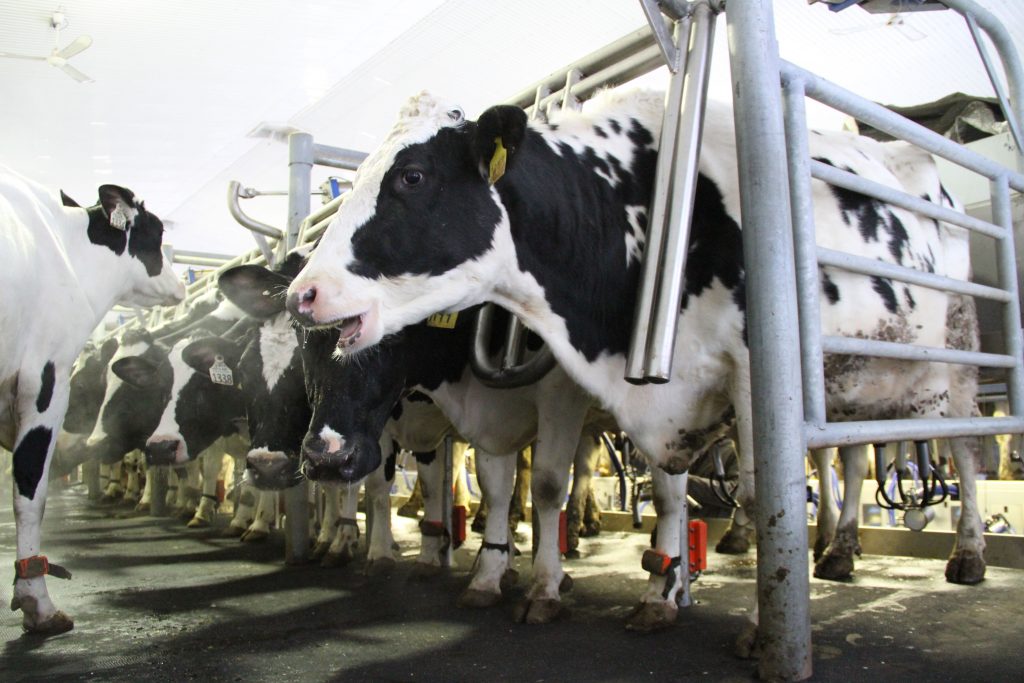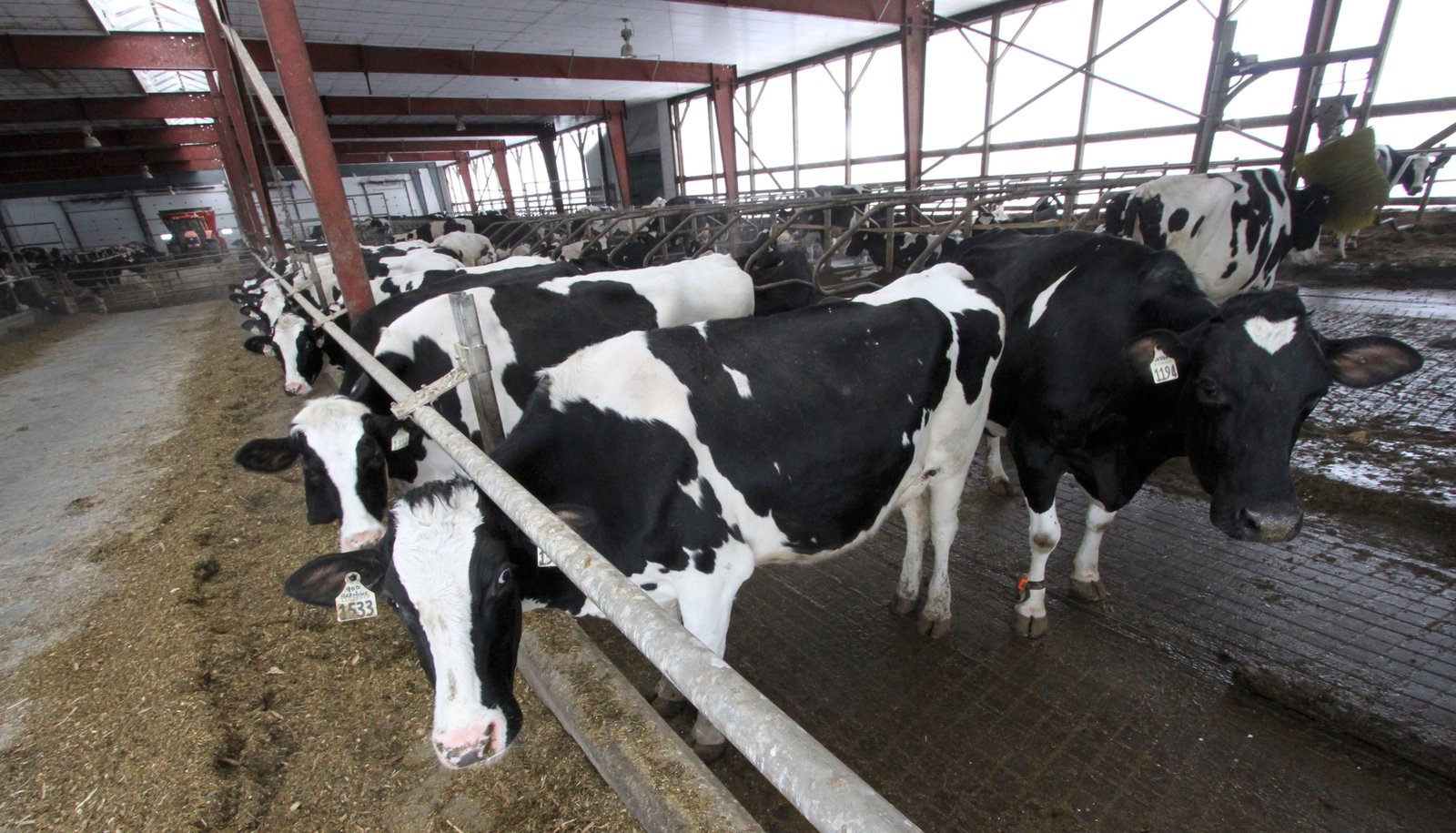By David Dodge and Duncan Kinney
French fry oil, molasses, donuts and cow manure. No, it’s not the grossest Tim Horton’s ever, it’s called biogas and Canadian farmers are starting to wrap their heads around this farm diversification idea.
Growing up in Alberta it’s pretty hard to forget the smell of fresh manure being spread on a nearby field. That’s why when James Callaghan, a dairy farmer from Lindsay Ontario, first heard about biogas he was intrigued. Not only was it a way to deal with environmental concerns about local water and animal waste but he could diversify his farming operation by generating heat, electricity, animal bedding and a near-odourless fertilizer.
If you haven’t been to a working dairy farm in the past ten years you might be surprised at the technological whizbangery of it all. Stainless steel is everywhere, cows are brought into automated milking stalls on an elevated platform at milking time and in the barn slow moving, automated pooper-scoopers carry the manure away.
This is how it all works at Maryland Farms, a fifth generation dairy farm about two hours east of Toronto. Callaghan is a genial guy who can crack a joke about the last time the Leafs won a Stanley Cup and then in the next minute get into the intricacies of running an underground cooling field with pipes full of hot gas. He runs the farm with his two brothers and two of his sons, who are getting into the business as well.
While milk might be their primary business it turns out that what those slow moving pooper-scoopers collect can be turned into a valuable resource as well – electricity. It’s a fairly simple process – when organic material, like cow manure or vegetable waste, breaks down in an oxygen-free environment it produces methane, the main ingredient in a product that most everyone knows as natural gas.

James Callaghan and his two brothers run Maryland Farms, a 250 cow dairy operation that set up a biogas operation on their site two years ago. Behind him is the anaerobic digester.
This process is called anaerobic digestion and the methane that is collected is burned for electricity and heat.
“I never thought we’d be producing electricity here and selling it to the grid,” says Callaghan.
“We’ve been at it for a little of over a year. We’ve had a lot of learning experiences in that time but we’re not going to give up on this and we’re going to learn how to run it and we are getting better at it as time goes on.”.
Ontario is where the action is when it comes to biogas projects in Canada. According to the Biogas Association there are roughly 30 working on-farm biogas systems in Ontario capable of generating about 15 megawatts of electricity. There are another 49 biogas projects in the queue in Ontario as well with projects in B.C., Alberta, New Brunswick and Quebec.
Worldwide there are more 10,000 operational biogas plants that have a capacity of more than 5,000 megawatts. Europe leads the way with Germany, Italy, Czech Republic, the Netherlands and France as the strongest biogas markets in the world.
Not just for the money
While the potential for big bucks was a key factor in Callaghan’s decision the environmental factors played a role in his decision as well. Back in the early 2000s the idea of nutrient management in Ontario came up – nutrient management being the official bureaucratic term for regulating how much raw manure you can dump on your soil so it doesn’t affect local water sources. By using an anaerobic digester you mitigate the effects of dumping raw manure onto fields.
“One of the main reasons we started looking at this was because once your manure is digested the smell is eliminated when you go to spread that product back on the field. You also kill the majority of the pathogens in your manure as well so it’s better for the environment and better for the watercourses,” says Callaghan.
“It makes the neighbors happier as well.”
The stuff that’s left over from the anaerobic digestion is a dry, soil-like, spongey substance called digestate that smells like… well not much really. Not only does it get spread on the fields it also gets used as bedding for the cows.

Cow manure is collected from 250 milking cows at Maryland Farms and is used to power a 500 kilowatt engine that runs on the methane collected from the manure’s anaerobic digestion.
Methane producing bugs
It turns out that you can’t do it all with just cow manure. You need “FOGs” as Callaghan calls them. These FOGs are fats, oils and grease from the restaurant industry and they’re delivered to the farm by a third party. Creating the methane is a complex biological process and it’s a bit like Goldilocks, it has to be just right.
“Our best product in order to help produce methane would be French fry oil and molasses which are very high in energy and they work well with the manure to produce methane,” says Callaghan.
“But you always have your other products such as donuts that will have sugar and a lot of energy in them too. Instead of dumping it in landfill sites we’re taking it here and we’re reprocessing it and making methane out of it.”
It’s a tantalizing recipe: French fry oil, molasses, donuts and cow manure, shaken not stirred – all to make electricity.
More power on the farm
After the anaerobic digestion has happened, the methane bugs have done their work and the biogas has been harvested it’s time to put it to work. The methane is pumped through underground pipes to cool it down and to strip some of the moisture out of it before it heads to a large V12 engine. It’s a 500-kilowatt monster and being in the room when it was running was one of the loudest places I’ve ever been.
“All of the power that we produce we send it out to the grid. We get approximately $0.16 a kilowatt for whatever is being produced. We can go down as low as 250 kilowatts and still run that engine and up to a max of 500 [kilowatts],” says Callaghan.
That guaranteed $0.16 cents a kilowatt-hour rate is important to the viability of the project. Callaghan has a 20-year contract through Ontario’s feed-in tariff program and it helps innovators like Callaghan take risks on unfamiliar technology like this.
It was a little over $2 million initial investment and Callaghan hopes to have it paid off in ten years.
Callaghan also heats his house and several of the farm buildings with waste heat from the engine. Even after all of that there’s still leftover waste heat – He’s considering starting another business based around his bio-digester.
“We do have excess heat here and we definitely could put up a greenhouse and grow vegetables. That’s another business that could happen in the future but right now we’re going to work on this unit and make it as efficient as possible,” says Callaghan.
Spoken like a true farmer.


